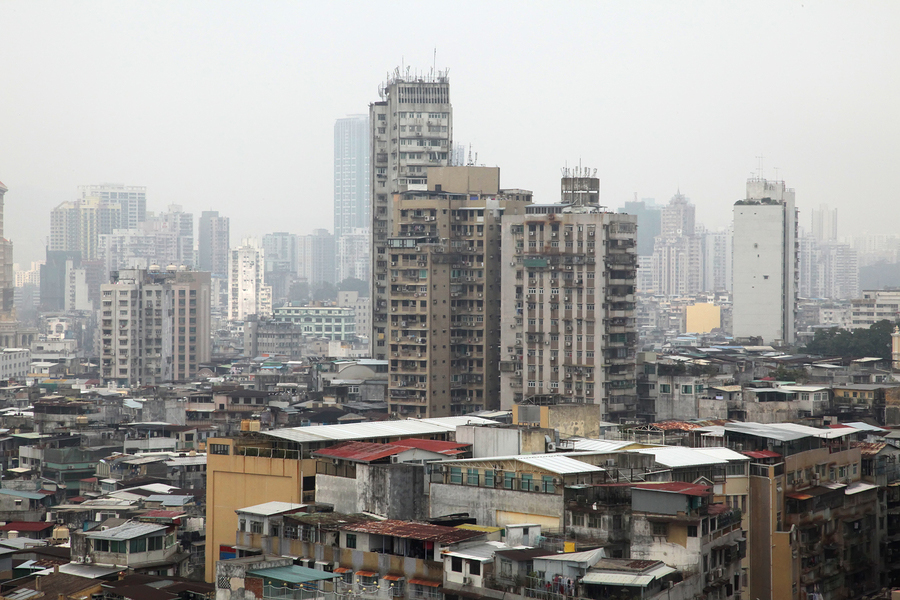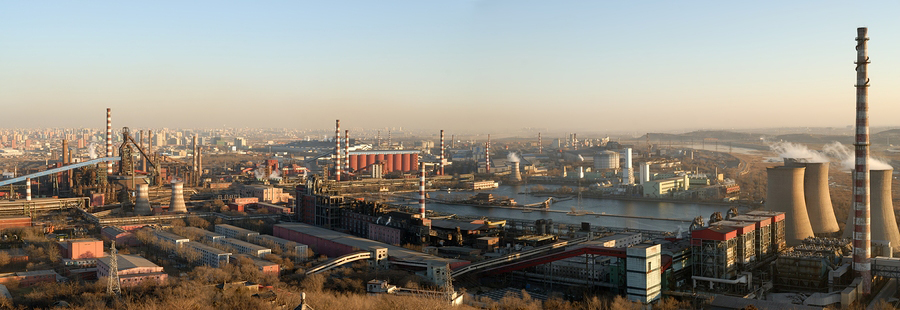Deadly Smog
Air Date: Week of February 8, 2013

Pollution in China (photo: bigstockphoto.com)
Deadly smogs in the mid-20th century caused the United States and Great Britain to pass clean air legislation. Now, Beijing has the world’s thickest smog, and the health problems could be serious. Beijing journalist Jocelyn Ford tells host Steve Curwood about the air she’s breathing. Then, Dr. Tracey Woodruff explains her new study linking air pollution to low birth weight.
Transcript
CURWOOD: It’s Living on Earth, I'm Steve Curwood. They used to sing about Foggy London town, but after World War II the British capital was more famous for its swirling smog, from coal burning power plants, coal fires in the hearth and diesel buses and trucks. The worst incident came in December 1952.
MAN1: “I don’t think the bleeding devil himself could have driven it all away. It was that thick. From that night it was vicious.”
WOMAN: “It was a warm fog. It was wrapped around you. It was all possessing.
MAN2: “It was smelly. It was dirty. It was black.”
MAN3: “It had an acrid, acidy feel about it.”
MAN4: “It seeped into the houses and indoors, everywhere was covered with grey film. It was quite uncanny."
CURWOOD: As many as 12,000 deaths were blamed on that killer smog and the British government was forced to act, passing the Clean Air Act in 1956. The United States, which had its own killer smog in Donora, Pennsylvania, in 1948, passed its own Clean Air Act in 1963. Since then, health problems due to poor air quality have fallen dramatically in both countries.
Without similar environmental protections, China is now facing a dirty air crisis, with toxic levels of air pollution throughout Beijing this past month. Jocelyn Ford is a journalist and a filmmaker based in Beijing, and she joins us via Skype. Welcome to Living on Earth!
FORD: Hello!
CURWOOD: So what's it like there, or particularly, what’s it like to take a breath there?
FORD: Well, on a bad air day, I actually try not to go outside because I don't want to be breathing in the equivalent of a pack of cigarettes a day. You can feel it in your lungs; your throat gets all clogged. It’s really not very pleasant. I tried to avoid even going to yoga so I wouldn’t have to breathe deeply!
CURWOOD: So how far can you see from your apartment?
FORD: I usually see...I have a wonderful view. I’m on the 16th floor. I can see all sorts of skyscrapers miles away. But this past month it's more or less like a Chinese ink painting with a little bit shade of grey the further you good, and then it becomes totally misty.
CURWOOD: What are people saying in the press in particular about the air? Any criticism of the government?
FORD: This first time that Chinese state media has really been paying attention to the dangers of bad air. Back in 2008 when China started to clean up its air for the Olympics, the air would be bad and people would say, “oh, its just fog,” because the media never talked about the smog. But now people are aware that the air is bad, the Chinese government has started making public meetings on just how bad the air is. People are becoming much more concerned about their health and about their children’s health. There’s a lot of concern for example that kids shouldn't be outside playing in the playground when the air is really putrid. And the public is really up in arms about this. They want the government to do a lot better job, and there are a number of foreigners who are now think about, “is it really worth staying in China with all of this?”
CURWOOD: And what’s your answer? Are you coming home?
FORD: The days when the air is bad and the internet doesn't work, I think, what am I doing here? [LAUGHS]
CURWOOD: You know, we’d send you a bottle of oxygen, but probably the government wouldn’t allow it.
FORD: Actually, they’re already selling it here so I’m afraid we can probably get it cheaper.
CURWOOD: [LAUGHS] Jocelyn Ford, filmmaker and journalist. Thank you so much.
FORD: Thank you.
CURWOOD: Well, Feb 9th sees the start of the Year of the Snake, and the Chinese people love nothing more at New Year’s than to let off fireworks which could worsen their smog. Scientists know that air pollution causes multiple medical problems for the people who breathe it in, but now a team of researchers from around the world has demonstrated a connection between dirty air and low birth weight. Mothers exposed to high levels of particulates, the scientists found, are more likely to give birth to underweight children, putting them at risk of developmental delays and illness.
One of the study's lead authors is Dr. Tracey Woodruff, the Director of the Center for Reproductive Health and the Environment at the University of California at San Francisco. She says that the size of the study’s sample shows that their conclusions should be taken seriously.

Dr. Tracey Woodruff (photo: UCSF)
WOODRUFF: We had over three million births in our study, so this makes it a very large study. In fact, we think it’s the largest study that’s been done to date to look at this question about maternal exposure to air pollution and its effects on birth weight.
CURWOOD: Now in which countries did you do your research?
WOODRUFF: We had participants in 14 centers on every continent except for Africa. We had several researchers in Europe, Brazil, Seoul, Korea, Australia, Vancouver, Canada and several locations in the United States including in California, New Jersey, Connecticut and Massachusetts. A lot of people have been conducting studies in their individual countries looking at air pollution and adverse pregnancy outcomes, both low birthweight and pre-term delivery. And they all worked out a little differently, they all found slightly different results so we gathered all the researchers together.
Through our discussions, we realized if we worked together we might have a stronger ability to look at this relationship between air and pollution pregnancy outcomes. We developed a protocol that everyone would do the same method in each of their studies. They acquired the same protocol, gathered the results, we aggregated them, and that was the result of the study. We can actually look across all the centers and pull all the information together to get a robust estimate about the relationship between maternal exposure to air pollution and low birth weight.
CURWOOD: And what did you find?
WOODRUFF: What we found was that there's an increased risk of low birth weight with increasing levels of particulate matter in air pollution.
CURWOOD: What was the increased risk?

Steel plant in Beijing, China (photo: bigstockphoto.com)
WOODRUFF: We saw an increased risk of 3 percent in low birth weight. It's not a very large increase for one person, but we’re talking about millions of pregnant women around the world were exposed to this. Because so many people are exposed you can have many people who were infected across large populations.
CURWOOD: Why does birth weight matter so much? What is it such an important statistic?
WOODRUFF: Birth weight is a very important indicator of essentially fetal health and doctors and public health practitioners are all concerned about the extent to which there’s low birth weight in the population. Babies who are born too small can be at increased risk of chronic conditions either during infancy or in childhood. Things like increased risk of infection, they might have developmental delays. And now we know that being born too small at birth can be an increased risk of adult disease. So things like cardiovascular disease, diabetes, what we call metabolic disorders, so really being born too small can set you off on a less healthy path in life.
CURWOOD: We're hearing a lot about air pollution in China right now, what would your study suggest might be going on in terms of the long-term effects of this rather poor air quality?
WOODRUFF: It reminds me of that earlier pollution episodes that actually led to the regulation of particular matter air pollutions, such as the London Fog of the 1950s, which also had very high levels of pollution. In terms of reproductive and developmental health concerns, the London Fog episode, well, they saw people actually dying and going to the emergency room in the hospital. They also saw an increase in infant mortality from that very high air pollution episode. And I would anticipate that in China that would be an issue for very young infants, and I would also anticipate that this would be affecting pregnant women, and increasing their risk of potentially adverse pregnancy outcomes.
CURWOOD: What do you hope comes out of this research?
WOODRUFF: Well, one of the reasons we were very interested in doing this research is to be able to provide people who are trying to make decisions a better estimate about the relationship between air pollution and pregnancy outcomes. The decision-makers are looking to figure out ‘if I have to do a regulation on air pollution, what are the potential benefits from regulating air pollution?’ And when they look in the scientific literature, it is often difficult to understand the meaning of what the different studies say because it’s not aggregated in a way that's useful for policymakers. So a second goal of the study was to essentially provide a better understanding about the relationship and then estimates that can be useful for people trying to make decisions about air pollution.
CURWOOD: Tracey Woodruff is the Director of the Program for Reproductive Health and the Environment at the University of California at San Francisco. Thank you so much, Professor Woodruff.
WOODRUFF: Thank you.
Links
Maternal Exposure to Particulate Air Pollution and Term Birth Weight
Program on Reproductive Health and the Environment
Toxic matters- tips for families for lowering chemical exposures
a story about doctors and the challenges of talking about environmental exposures
Living on Earth wants to hear from you!
Living on Earth
62 Calef Highway, Suite 212
Lee, NH 03861
Telephone: 617-287-4121
E-mail: comments@loe.org
Newsletter [Click here]
Donate to Living on Earth!
Living on Earth is an independent media program and relies entirely on contributions from listeners and institutions supporting public service. Please donate now to preserve an independent environmental voice.
NewsletterLiving on Earth offers a weekly delivery of the show's rundown to your mailbox. Sign up for our newsletter today!
 Sailors For The Sea: Be the change you want to sea.
Sailors For The Sea: Be the change you want to sea.
 The Grantham Foundation for the Protection of the Environment: Committed to protecting and improving the health of the global environment.
The Grantham Foundation for the Protection of the Environment: Committed to protecting and improving the health of the global environment.
 Contribute to Living on Earth and receive, as our gift to you, an archival print of one of Mark Seth Lender's extraordinary wildlife photographs. Follow the link to see Mark's current collection of photographs.
Contribute to Living on Earth and receive, as our gift to you, an archival print of one of Mark Seth Lender's extraordinary wildlife photographs. Follow the link to see Mark's current collection of photographs.
 Buy a signed copy of Mark Seth Lender's book Smeagull the Seagull & support Living on Earth
Buy a signed copy of Mark Seth Lender's book Smeagull the Seagull & support Living on Earth

